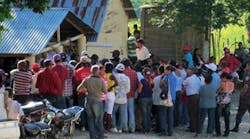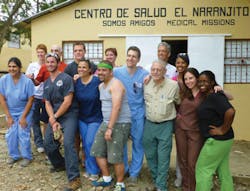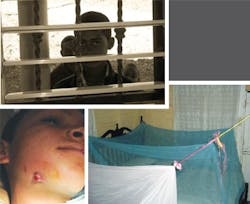Somos Amigos outreach inspires public health efforts in other areas
by DIANA MACRI, RDH, BSDH, MSEd
For the first time, the United States Department of Health and Human Services has listed oral health as a leading health indicator on the Healthy People 2020 agenda. "The health of the mouth and surrounding craniofacial (skull and face) structures is central to a person's overall health and well-being."2 High-priority health issues are addressed, in detail, in the report. Included in the department's objectives regarding oral health:
- Increase awareness of the importance of oral health to overall health and well-being
- Increase acceptance and adoption of effective preventive interventions
- Reduce disparities in access to effective preventive and dental treatment services
Dental hygienists are the oral health professionals who are optimally qualified to address these objectives. Dental hygienists have the qualifications and resources to become involved in community organizations, enact programs, and facilitate partnerships with other professions.
In 2011, the ADHA commissioned an environmental scan, which succinctly states our challenge:
"This is the very time you need to learn and adapt to a changing environment. … Whether you are a new entrant to dental hygiene, an accomplished practitioner, or an elder in the profession, you have a role to play in shaping the identity and future of the profession. … Making sure every community has access to high quality oral health care requires dental hygienists to go outside their comfort zone and lead change from the frontlines."4
I earned a bachelor's degree in dental hygiene and a master's degree in higher education. I work as an instructor in the dental hygiene departments of New York City College of Technology (NYCCT) and New York University College of Dentistry (NYUCD). I have always felt the need to share my knowledge and expertise to help those in need, but opportunities were not always available – until a student at NYCCT, Daniel Lopez, relayed his outreach experience with an organization called Somos Amigos. After hearing about his adventure, I had to get involved.
My first Somos Amigos experience
Packing for the trip to Naranjito had to be light, as the accommodations there are humble. Select families act as hosts, providing food and lodging for the volunteers. I lived in Puerto Rico and Costa Rico for several years when I was a child and I'm fluent in Spanish. Daniel told me what I could expect from the program, so I thought I had a good idea of what the country and climate would be like. I felt I was prepared for this experience. Looking back now, I laugh at my naiveté!
Somos Amigos has a medical clinic and pharmacy, so there were nurses, nurse practitioners, and physicians, as well as support personnel such as translators, technical support, and administrative staff. There were also several college students and teenagers who were there to help. Some were like me, there for very much the same reasons I was, with a simple desire to help people. The first night in the Dominican Republic, we all chatted and ate, said goodnight and got to bed early, excited to get to Naranjito and begin our work.
The next day we boarded vans and drove to Naranjito, a two-hour trip into the hills and countryside. Once there, we unpacked all the supplies and prepared the clinics for the patients' arrival the next day.
We rose the next morning at 6:30 to roosters crowing and a majestic, radiant sunrise and walked to Lourdes' house. Lourdes is the matriarch of the community. If you can imagine a female version of a priest, that's what she is. People in the community look to her for advice, guidance, and support. She is energetic, intelligent, deeply religious and generous. Her house was where we ate all our meals. We walked to the clinic after breakfast and saw that patients had been waiting since the wee hours of the morning. There were two hygienists on this trip – myself and Daniel. I saw patients of all ages and oral conditions. Rarely was there a patient who just needed a routine prophylaxis. Many of the children had severe decay and needed extractions. I saw many adolescents with missing molars that had been extracted on previous trips by Somos Amigos volunteers. I saw pregnant women with advanced periodontitis. Most of the patients had heavy calculus accumulation and needed additional treatment, which I could not provide because there were so many others waiting to be seen. Some patients waited all day for a prophylaxis; others were turned away and had to return the next day. We worked until 8 p.m. that first day, and I was absolutely exhausted! I was happy that my years of experience in dentistry enabled me to help the people of Naranjito, but I also felt sad that I couldn't provide treatment at the standard to which I was accustomed. In addition to scaling, root planing, and polishing, I applied fluoride varnishes and sealants. X-rays were not exposed, because the equipment was not yet available.
I sometimes helped the dentist and dental students who were providing the dental services. There was a pediatric dentist who, not being fluent in Spanish, had the added difficulty of trying to communicate with young patients who did not understand her. The dental students did many fillings at one sitting, knowing that the patients would be in pain if their teeth were not restored. Worse, the teeth could cause potentially life-threatening infections. They performed challenging extractions that would usually be reserved for oral surgeons. They were an extremely impressive group of young people who worked diligently and conscientiously every day.
We worked like that for four days. I adjusted and developed a routine and overcame my feelings of sadness over not being able to do more. Somos Amigos founder Frank Brightwell was always walking through our clinic with his ever-present smile, making sure we were all okay. The feeling of camaraderie and service, and the knowledge that our actions were directly improving people's lives fueled us and gave us the energy to keep working. On that trip, 218 patients were treated.
Kaitlin M. Stier Smile for Life Foundation
Kaitlin Stier graduated with her bachelor's degree in dental hygiene from NYUCD. She immediately began working in a practice in Poughkeepsie, N.Y, and, more recently, became a part-time faculty member at NYUCD. Last year, she began noticing the effects of a down economy in her office. She told me, "Patients that would have gotten an implant five years ago are now getting bridges. A lot of my patients are losing their dental insurance." Her office had started accepting Healthplex, a government-based insurance for children that offers minimum preventive coverage (they deny sealants). Seeing that there was a need for dental services, Kaitlin wanted "to reach as many people as possible in the most affordable and manageable way." She decided to start her own foundation.
The Kaitlin M. Stier Smile for Life Foundation had its first event on April 28, 2012, targeting children. "I chose kids first because I'd be able to see more children than adults. Also, I wanted to educate them and their parents on good oral health habits so they won't have as many dental problems in the future." She contacted local newspapers and they put out a brief press release stating that the foundation was offering free care to children without dental insurance. "We also sent a copy of the press release to all the local elementary schools. After the press release, we started to get phone calls from local politicians and dental companies who wanted to be involved." Congressman Maurice Hinchey and Legislator Richard Perkins from Dutchess County all participated in spreading the word about the event and visited the office to lend their support. Staff at the office volunteered their time, Dr. Ian Stier provided the facilities and use of radiographic equipment and supplies, and Henry Schein donated products for the kids. In four hours, the volunteers treated 50 children.
Kaitlin hopes to expand her foundation and be able to treat all patient populations, not just children. She also hopes to include restorative services by enlisting the help of volunteer dentists.
Public Health and Dental Hygiene
Public health has been a component of the dental hygiene profession since its creation. Alfred C. Fones and Irene Newman both felt very strongly that dental hygienists had a responsibility to educate and treat all people. It is the core ideology of the ADHA and the first item on its 2012-2015 Strategic Plan – "Helping dental hygienists to achieve their full potential as they seek to improve the public's health."1
Kaitlin Stier worked in a private practice, saw the need for dental care in her community, and started her own foundation. We should all follow her lead. Faculty members in accredited programs should be constructing programs involving community service for their students. For example, dental hygiene students at the University of Southern Indiana participate in a service-learning project providing oral cancer screenings and oral health education to residents of the Women's Addiction Recovery Manor. Barbara Berentsen, a dental hygienist and faculty member at Stony Brook University, was instrumental in the formation of a program designed to provide care to developmentally disabled children and adults at Stony Brook University.
Lack of access to dental care for all ages and demographics remains a public health challenge. The Census Bureau projects that the elderly population of the U.S. will grow by 12% by 2050. "The fact that the coming generations of elderly are maintaining their teeth poses a challenge for satisfying their dental care needs. As more people keep their teeth, more will be at risk for dental diseases and will need more preventive, restorative, and periodontal services,"3 according to the report "The Oral Health of Older Americans."
I have chosen to work with the developmentally disabled population. A colleague and I are scheduled to participate in the Family Support Resource and Transition Fair sponsored by the Staten Island Developmental Disabilities Council in partnership with the Richard H. Hungerford School and Lifestyles Education Center. We have invited our students to attend the event with us. We hope to create long-lasting relationships and, eventually, programs that will benefit students, patients, and caregivers.
The advantages of creating these programs are twofold. Primarily, people receive the oral care that they need to maintain health. Secondly, populations know and become familiar with dental hygienists and the myriad services and functions that dental hygienists provide. This opens the way for an expansion of the definition of dental hygiene as a profession.
As philosopher Lao Tzu stated, "A journey of a thousand miles begins with a single step." Somos Amigos founder Frank Brightwell began that organization 20 years ago as an educational opportunity for his high school students. Kaitlin Stier's impetus was to provide dental services and education to people who needed it. Because of their efforts, many people have received dental care. We must have faith in ourselves to forge new paths, be innovative in our approaches, and encourage collaborations across communities and professions for the benefit of all.
DIANA MACRI, RDH, BSDH, MSEd, is a faculty member of the dental hygiene departments at New York University College of Dentistry and New York City College of Technology. She can be contacted at [email protected].
Consider reading: Blue moon and whalelight
http://www.rdhmag.com/articles/print/volume-19/issue-7/feature/blue-moon-and-whalelight.html
Consider reading: Adventures for the hygienist’s spirit
http://www.rdhmag.com/articles/print/volume-19/issue-2/feature/adventures-for-the-hygienists-spirit.html
Consider reading: Dental tourism
http://www.rdhmag.com/articles/print/volume-31/issue-12/features/dental-tourism.html
References
1. ADHA Strategic Plan Year 2012-2015. (n.d.). Retrieved October 6, 2012, from http://www.adha.org/downloads/2012-2015_Strategic_Plan.pdf
2. Centers for Disease Control and Prevention. (2009, October 14). Retrieved from http://www.cdc.gov/nchs/healthy_people/hp2020.htm
3. Vargas CM, Kramarow EA, Yellowitz JA. (n.d.). The Oral Health of Older Americans. Retrieved October 6, 2012, from http://www.cdc.gov/nchs/data/ahcd/agingtrends/03oral.pdf
4. Dental Hygiene at the Crossroads of Change. (n.d.). Www.adha.org. Retrieved October 6, 2012, from http://www.adha.org/downloads/ADHA_Environmental_Scan.pdf
Somos Amigos Medical/ Dental Missions
Somos Amigos is a nonprofit organization that provides medical, dental, and humanitarian services and support to people living in medically underserved areas of developing countries and to others living in poverty. In 1997, Somos Amigos sent their first medical and dental team to the Dominican Republic. The organization first committed to the community of Naranjito. An isolated and rural community in the mountains, the region has no economy-subsistence farming is the way of life.
The medical and dental clinics are stocked through the generosity of many in the medical, dental, and pharmaceutical communities. The participants in the Somos Amigos programs are volunteers who pay their own travel expenses (approximately $700, which covers airfare and hotel fees for two nights).
If you would like more information or to make a donation:
Somos Amigos Medical/Dental Missions
P.O. Box 2351
Saratoga, CA 95070
http://somosamigos.org/
http://www.facebook.com/#!/SomosAmigosMedicalMissions?fref=ts
Kaitlin M. Stier Smile for Life Foundation
http://www.facebook.com/#!/pages/Kaitlin-M-Stier-Smile-for-Life-Foundation/[email protected]
Past RDH Issues









